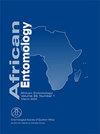平海绿僵菌和罗伯特绿僵菌的配方及其贮存后对假球菌(半翅目:假球菌科)的感染潜力
IF 1.2
4区 农林科学
Q3 ENTOMOLOGY
引用次数: 0
摘要
昆虫病原制剂是指将粘土、矿物油等各种惰性成分与昆虫病原活性成分混合。成功的配方提高了昆虫病原体的存活率,也简化了它们的运输、储存、制备和应用。本研究的目的是开发一种配方,以保持大量生产的当地平海绿僵菌和罗伯特氏芽孢杆菌分生孢子的寿命和致病性,为将来在地上的商业领域应用于viburni假球菌。其目标是制定一项具有成本效益的方案,以制定感染性传播体,并在实验室条件下测试其有效性。以液体石蜡油、椰子油、菜籽油和橄榄油为液体载体,硅藻土为矿物载体,配制了两种分离菌株的分生孢子。分生孢子活力和致病性在8周内进行评估。在研究中,我们观察到,在油载体中配制的分生孢子在8周的时间内,与在矿物载体中配制的分生孢子或作为干燥的分生孢子粉储存的分生孢子相比,两种分离菌株的分生孢子活力和存活率都保持在95%左右。所有油制剂的分生孢子对威伯氏假体的致死率均较高,平哈氏假体的致死率为60% ~ 90%,罗伯氏假体的致死率为70% ~ 90%。两种分离株的分生孢子在油制剂中储存后仍能保持活力和致病性,这增加了当地分离株在野外条件下成功整合为威伯尼假单胞虫生物防治剂的可能性。本文章由计算机程序翻译,如有差异,请以英文原文为准。
Formulation of Metarhizium pinghaense and Metarhizium robertsii and the infection potential of the formulations against Pseudococcus viburni (Hemiptera: Pseudococcidae), after storage
Formulation of entomopathogens refers to the mixing of various inert ingredients, like clays and mineral oils, with the active ingredients which are the entomopathogens. Successful formulation enhances the survival of the entomopathogen and also eases their transportation, storage, preparation and application. The aim of this study was to develop a formulation to maintain the longevity and pathogenicity of the mass-produced conidia of local Metarhizium pinghaense and M. robertsii, for above-ground future commercial field application against Pseudococcus viburni. The objectives were to develop a cost-effective protocol for formulation of infective propagules and to test their effectiveness under laboratory conditions. The conidia of both isolates were formulated using four different oils (liquid paraffin, coconut, canola and olive oils) as liquid carriers, and diatomaceous earth as a mineral carrier. Conidial viability and pathogenicity were assessed over a period of eight weeks. In the study, it was observed that the conidia formulated in oil carriers maintained a high conidial viability and survival rate of >95 % over a period of eight weeks for both isolates, relative to when formulated in mineral carriers, or when stored as dry conidial powder. The conidia in all the oil formulations were also observed to induce high mortality, ranging between 60 % and 90 % for M. pinghaense, and between 70 % and 90 % for M. robertsii, when used against P. viburni. The ability of conidia of both isolates to maintain viability and pathogenicity, following storage in the oil formulations, increased the likelihood of the local isolates being successfully integrated as biological control agents for management of P. viburni under field conditions.
求助全文
通过发布文献求助,成功后即可免费获取论文全文。
去求助
来源期刊

African Entomology
生物-昆虫学
CiteScore
2.00
自引率
0.00%
发文量
17
审稿时长
6-12 weeks
期刊介绍:
African Entomology (ISSN 1021-3589 – print / 2224-8854 – online) replaced the old Journal of the Entomological Society of Southern Africa in 1993. A single volume consisting of two issues (March and September) is published annually. The journal is indexed in all major abstracting journals
African Entomology is a peer reviewed scientific journal that publishes original research articles and short communications on all aspects of entomology, with an emphasis on the advancement of entomology on the African continent.
 求助内容:
求助内容: 应助结果提醒方式:
应助结果提醒方式:


